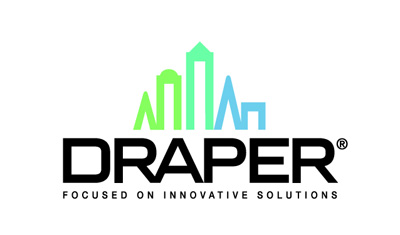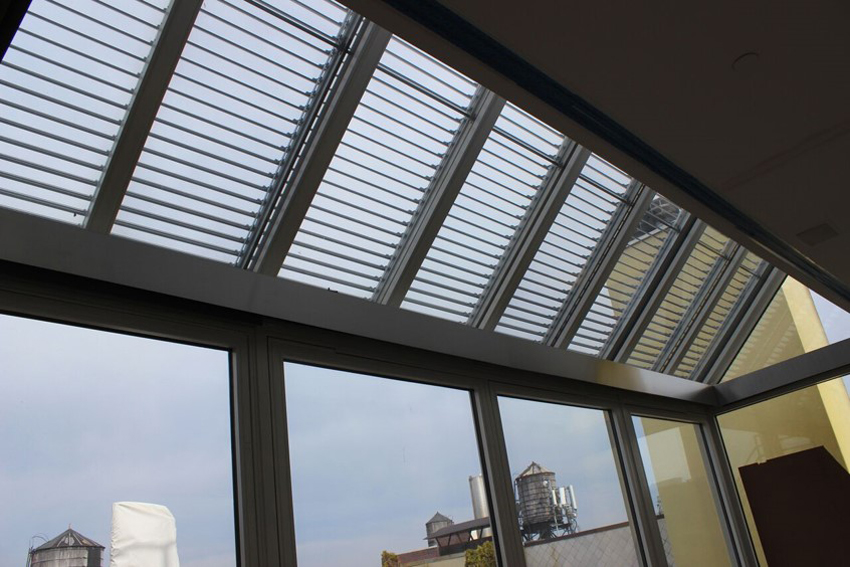Mitigating Glare and Solar Heat Gain with Exterior Shading Systems
“So it is important that when automation occurs, people understand why it is happening, and intuitive controls that allow them to return to their preferred state or modify certain aspects of their environment are critical to maintaining occupant confidence in building systems,” he recommends. “If people understand that an automated shade is deploying to maintain conditions of comfort in their space, yet they can still act to modify it within some boundary condition, they will have a better relationship to the technology.”
Along these lines, Fragali says it is important to determine the building owner’s daily needs and expectations of their individual shading system. “Location and exposure are essential to consider when selecting the ideal materials and finishes, as well as educating your client on the required maintenance for each individual material selected,” she says.
Controls generally allow for varying degrees of user override and are also designed to capture systems back into automatic after a period of time to ensure that solar control of the building is maintained. User override can be achieved through switches and can interface with other systems, such as the building management system/building automation system (BMS/BAS) or audio visual (AV) system.
In the United States, the BACnet protocol is generally used for integration with the BMS/BAS, although other communication protocols can be used as well. BACnet over IP is the predominant BMS/BAS integration method. The head end of the shading control system is connected to the building IP network. This allows two-way communication, with the BMS/BAS being able to obtain information about the status of the shading devices as well as providing commands to move the shading systems as appropriate, for example if there is a fire alarm.
It is also possible to customize the control system to meet the specific requirements of a project. For example, the design team can specify when and to what extent the shading system will be deployed. In addition, operations at deployment and overrides are site-configurable components of a wel-engineered control system. Overrides are particularly important in terms of setting priorities for the various lighting, AV, fire protection, and other systems that may be integrated with the shading control system. A proper control system that is automated and comissioned correctly requires little end-user override and makes shading operations much less noticeable.
Control systems can allow for a wide range of methods of integration, including a BMS/BAS interface, as noted, an RS 232/485 AV interface, or an interface with other systems by means of contact closures.
On the topic of aesthetics for the interface, there is generally standard artwork for the switches, but this can be customized on larger projects.
Enhanced end-user interaction can include a custom switch to allow both the shading systems and operable windows to be controlled from the same interface. Switches can also incorporate status LEDs.
Conclusion
In summary, properly controlled exterior shading systems are a key strategy for optimizing the benefits of daylighting, controlling solar heat gain, and mitigating glare. While there are a number of options, architects and designers regard fabric zip systems, venetian blinds, and rack arm systems as effective shading solutions in achieving these requirements.
“We find that all three systems are easily maintained and can be customized to fix any project needs. They offer a wide range of colors and finishes for any design we wish to achieve, making them well suited for any project,” reports Fragali.
In conclusion, she emphasizes the effectiveness of exterior over interior systems. “Unlike interior shading systems, exterior examples maximize the amount of ambient light into the building while preventing any direct sun penetration, which is essential to the design of any project.”
END NOTES
1“Study: Natural Light Is the Best Medicine for the Office.” 31 January 2018. Web. 20 July 2020.
2Meister, Jeanne C. “The #1 Office Perk? Natural Light.” Future Workplace. 3 September 2018. Web. 20 July 2020.
3Ander, Gregg D. “Daylighting.” World Building Design Guide. 15 September 2016. Web. 20 July 2020.
4Malmquist, Derek. “A Glaring Issue: The Negative Implications of Glare in the Workplace.” 12 May 2016. Web. 20 July 2020.
 |
Based in Spiceland, IN, Draper manufactures projection screens, AV mounts and structures, window shades, and gymnasium equipment. The family-owned and -operated business was founded in 1902 by Luther O. Draper and is owned and managed by his descendants. With locations in the United States and Sweden, Draper ships products to dealers throughout the United States and more than 100 countries. To learn more about Draper, visit www.draperinc.com. |










